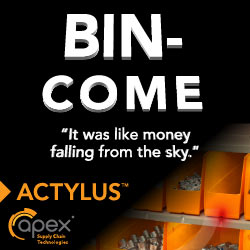All that (Supply Chain) Jazz: The LLamasoft User Conference
It's not easy to get away with using two metaphor's to describe the general supply chain environment, but I will say LLamasoft founder and CEO Don Hicks pulled it off.
I am literally just back from LLamasoft's 2016 user conference in New Orleans, the sixth such event that moved out of its Ann Arbor, MI home for the first time last year, when it was in Park City, UT.
Around for some 15 years, LLamasoft in recent times has rapidly emerged as the overwhelming leader in supply chain network optimization software, or what it prefers to call supply chain design. It argues, effectively, that (a) design has generally received insufficient attention in most companies; and (b) design has emerged as a true third competence in supply chain practice, in addition to planning and execution.
| GILMORE SAYS: |
Will what has made LLamasoft so successful on the supply chain design side work equal well for traditional planning? That remains to be seen.
WHAT DO YOU SAY?
Send us your
Feedback here
|
I agree wholeheartedly with both propositions, though I add risk management as a fourth core competence. The message is working, with a substantial percentage of the Fortune 100 using LLamasoft's Supply Chain Guru tool, resulting in some 500 attendees at this year's event, with well-known companies from across the globe in attendance.
What LLamasoft has achieved organically, through a combination of really focusing on advancing its design software while competitors moved more slowly, plus a different-than-most focus on customer success, has recently been augmented by buying up most of what had remained as competition. First it acquired the LogicTools solutions from IBM in 2015, and then a more Euro-focused provider called Barloworld Software early this year. The latter deal was made possible by the investment of $50 million from an arm of Goldman Sachs that valued LLamasoft at some $250 million, no doubt making Hicks very happy indeed.
The Barloworld acquisition had other ramifications as well, which I will discuss in a moment.
Back to metaphors: a decision to engage former world chess champion Gary Kasparov as the first day keynote speaker led to comparisons of supply chain to a chess match, and a conference theme of "What's your move?"
Certainly others have compared supply chain to chess, but it's apt enough: strategy, execution, battling a competitor in a series of back and forth moves, etc. But even more apt may be a version of the game I was not familiar with, called chess boxing, popular in parts of Europe.
In this game, contestants battle on the chess board for a few minutes, then put on the gloves for a round of real boxing,then back to chess, etc. Maybe that's more what supply chain is like today, with traditional competition and unwritten but understood rules in a game that still must be played even as someone like Amazon comes along delivering body shots and maybe a knockout punch at the same time. Search chess boxing on YouTube to see this strange sport.
But, Hicks later said, maybe supply chain is a little like music too. You can try to have a highly structured, top down approach, like band or orchestra tightly controlled by conductor, under a strict set of predefined rules. But the results may be too predictable, and not flexible enough. On the other end, musicians each playing their own tune, uncoordinated (functional silos?) results in music (and supply chain performance) that is simply discordant.
But then there is jazz, in which musicians follow the same basic melody and tempo, but can improvise within that framework to delivered a better total result, as the small band Hicks brought on stage well demonstrated.
So should our supply chains be more like a jazz band or an orchestra? I am going to do some thinking about that.
There were two main company announcements at the conference. First was the coming release of what LLamasoft is calling Supply Chain Guru X (as in letter X not "ten"). I received a private demo yesterday, and loved exec VP Toby Brzoznowski's term "the developer's debt," referring to the price almost any software company pays as it expands its solution over time: more compromises as new capabilities are added, an inevitable sort of code bloat and more, limiting in the end the path forward.
LLamasoft has bitten the bullet and totally rewritten its flagship design software with a "clean slate" approach, and it is impressive. Highlights include a totally flexible data model, versus a more rigid structure previously, almost limitless ability to construct process steps across any supply chain function, and assign costs and other attributes to each process step. In addition to being valuable for traditional supply chain design work, this capability now enables LLamasoft to model "four wall" distribution center processes it really couldn't address before, getting much more granular on costs, capacities and constraints than just the sort of basic throughput numbers you could have assigned to a DC previously.
There is a very cool new dashboard capability in which users can with extreme flexibility combine supply chain maps, data views, and analytics/graphs into the precise views they want, and on the graphics side in some/many cases eliminating the need if desired to use a third party tool such as Tableau. Equally cool is a tool in which modelers can create and publish to the Cloud "what if" type capabilities for business users to explore different scenarios and see the result from changes in assumptions, hiding all the complexity of the models behind it. There's more, but you get the idea. Guru X will be available sometimes near year's end.
Just as consequential, LLamasoft is entering the traditional planning software fray in an increasingly big way. It was already headed that direction in 2015, building out a new set of tactical planning apps in addition to the existing strategic planning tools. But that direction was accelerated by the Barloworld acquisition, which in addition to bringing another network optimization tool also added demand and replenishment planning applications, with over 100 customers.
LLamasoft VP Jeff Meterksy showed a Gartner framework for supply chain planning software that had at least a couple of dozen distinct planning modules. LLamasoft had checks next to most of them, indicating either LLamasoft now had that capability or was developing it.
This is very consequential for the supply chain planning market, depending on LLamasoft's strategy and execution, but as I said after last year's conference, to a degree (slightly different now with the Barloworld solutions in the fold) LLamasoft will be coming at this from the top down (strategy and design) as the entry point, versus traditional planning vendors who comes more from the bottom up (demand and supply planning).
Will what has made LLamasoft so successful on the supply chain design side work equal well for traditional planning? That remains to be seen. The competition will be tougher, that's for sure, and will include ERP providers as well as best of breed, something the company really doesn't encounter on the network design side.
It may not be fair based on one 45-minute presentation, but I think to be successful breaking into this market in a big way Llamasoft will need to up its vision and messaging relative to planning, which was a bit incremental versus a more "new way" approach I believe will be needed to prosper in this very mature market.
I had hoped to review some of the several excellent breakout sessions I saw, such as ON Semiconductor's incredibly granular modeling of every production machine in every plant to greatly improve responsiveness to demand, drive the S&OP process, and improve factory utilization; how food giant Mondelez was able to build a global network design capability that is an interesting blend of centrally led practices with regional execution and led to big savings; IKEA's development of a total land cost model and tool that allows buyers to be much smarter about sourcing decisions; and Starbucks creation of a single, comprehensive logistics model (and internal design capability) to do short, medium and long-term design planning, savings many millions of transportation dollars already in the process.
I will hope to provide more details on these in the near future, maybe in video form.
Kasparov, who of course famously beat and then lost to an IBM computer in the late 1990s, was an excellent keynote speaker. Generally a conservative, he doesn't like Hillary, Bernie or Trump, and thinks the West is trading growth and innovation for financial security.
Good conference from Llamasoft. Spoke to many SCDigest readers there.
Any reaction to our summary of LLamasoft's user conference? Is jazz a good metaphor for how we might think about supply chains? Can LLamasoft be successful in the planning market? Let us know your thoughts at the Feedback section below.
|












